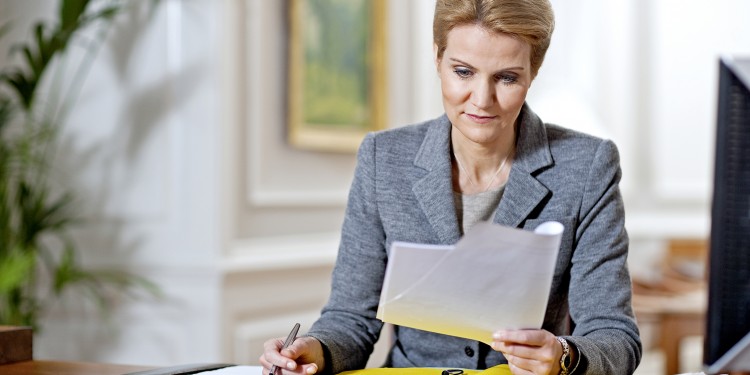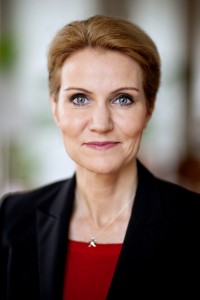Who is Helle? Well she never talks about it – but she is actually married to an expat
Her brother and sister placed a crown on her head just days after she was born on 14 December 1966. As the youngest of three, Helle Thorning-Schmidt seemed to have everything going for her right from the start.
By Inger Stokkink Pictures: PR
Outgoing, blonde and pretty, a quick learner, sociable; you name it. She took her parents’ divorce in her stride, maintaining good relations with both, did well in school and university, and managed to gain entrance to an international college that did wonders for her career.
In her own words, she is an optimistic person who cherishes her two daughters and her husband, likes to sing (second soprano), enjoys reading (but never has enough time to do as much as she would like), her all-time favourite being Jane Austen’s Pride and Prejudice. People who have met her are struck by her enthusiasm and, most often, her good mood. And if things don’t go well for her, she strikes back with black humour, always searching for a way forward. She has admitted that during her first years as head of the social-democrats, keeping her good mood could be difficult as she was faced with massive criticism. That’s something, she says, that she has learnt to do since then.
Her political drive
What drives her is a deep conviction that it is possible to change things for the better, to break the mould and shape new forms. She is also very goal-oriented. Thinking with your belly and your heart, as the Danish expression goes, is fine, but using your head every once in a while doesn’t hurt. She is practical and looks for solutions rather than resolutions.
Co-operation is in her political DNA. She favours working together, even across party boundaries, because she believes that listening to the minority is what makes a democracy strong.
In line with her consent-driven and practical outlook Helle Thorning-Schmidt is also a networker, both nationally and internationally. Over the years she has built up many contacts with people who are happy to help her if she needs backing up to get things done.
Career
And getting things done is her forte. Her career has been marked by her optimism and her work ethic, and by speaking up if she wants something. She went to Copenhagen University to read political science, and afterwards to Belgian town Bruges to earn a degree from the College of Europe, a post-graduate college in European Studies. There she met future husband Stephen Kinnock. Here she met adversity, too, as she failed her final exam the first time round. And there she got her first real taste for politics.
Europe was her entrance to political Denmark. Her first role was an administrative one at the European Parliament in Brussels. After that she worked in Denmark at LO (the Danish Confederation of Trade Unions) as a consultant. In 1999, she was elected as Member of the European Parliament (MEP) for the Danish social-democrats and returned to Brussels.
In 2004 she made the decision to come back to Denmark and run for Folketinget
Then it all happened at once. She became a member of Folketinget and two months after that she became chairman of Socialdemokraterne. A whole generation of social-democrats took a step backwards after a period in which the different ‘wings’ in the party had fought bitter wars against each other. The party realised that they needed to turn a corner and to do that they needed a new face. And that face was going to be hers. She won the day with her rallying cry: ‘I can beat Anders Fogh!’ the latter being the sitting statsminister from Venstre.
A steep learning curve followed. Learning the ropes of being a MF (Medlem af Folketinget, – member of parliament) while being chairman of the opposition party was hard work. Even though she was popular, there was opposition from within. She didn’t have a true working class background; she was too outspoken in favour of the European Union; she was a weak leader and distant, letting her lieutenants do the dirty jobs.
Controversy – good looks and married to an expat
Some aspects of her personal life were controversial too. Every woman in a visible social position is subjected to acid comments about the way she looks, and Helle Thorning-Schmidt was no exception. In Brussels she was frequently seen carrying a Gucci handbag, giving her the nickname Gucci-Helle. The label didn’t score points with the press or with some of her party. On the other hand, many of the other party members told her: ‘When we send you out to represent us, you should look nice.’ Or, in her own words: ‘Vanity, and political vanity, is to be too much interested in what your legacy is going to be. But looking good, in the sense of making an effort […] is a good old-fashioned social-democratic value.‘ Later, however, Helle Thorning-Schmidt sold the Gucci bag at a second-hand fair and gave the earnings to a hospital in Hillerød.
Another controversy is the way in which she and her husband lead their lives. For most of their marriage, she and Stephen Kinnock have had different addresses – she now living in Denmark, he in (among others) Russia, Switzerland and, more recently, Wales. The family’s base is in Copenhagen though, where Stephen returns every weekend.
This arrangement has raised both eyebrows and questions among Danes (not understanding the expat life, the Thorning family’s lifestyle also represents). One of those big questions being whether Stephen was evading Danish taxes. This issue developed into a full-blown political affair lasting several years, the Skattesag (see fact box).
Nonetheless, Helle managed to bring her own and other opposition parties together, and in the Folketing elections of 2011 the ‘red block’ won the majority; albeit a slender one. A historical siege, because she became the first female statsminister in Denmark, leading a minority government of three parties: Socialdemokraterne (S), Radikale Venstre (RV) and Socialistisk Folkeparti (SF).
As statsminister, a new learning curve started.
And again waves of criticism came over her and her cabinet. Too many compromises had been made with Radikale Venstre, who wanted a more liberal approach to economic issues. ‘Løftebrud‘, you broke your promise was the mantra that haunted her and her government.
Despite that and some other setbacks, she held on and recently her popularity crawled up again in the opinion polls, so much so that she is far more popular than the blue block leader, Lars Løkke Rasmussen. She celebrates her 10 years as head of Socialdemokraterne this year, but still finds herself being asked what the differences are between being a woman as Statsminister compared to a man. But, proving that she’s the archetypal politician, she refuses to be drawn: “When I am old and have time to write a book, I can fill a full one with all of my experiences” is all she will say. For now she prefers the focus to be on her achievements and political results.
The tax case – Skattesag
In 2011, the newspaper BT got hold of details about Helle Thorning-Schmidt and Stephen Kinnock’s tax forms. It was frowned upon that a prominent Danish politician like her had a partner who worked abroad and didn’t pay his taxes in Denmark. Danish SKAT then started an investigation into Kinnock’s whereabouts and working life, and in the end decided that he (and his wife) had declared their taxes correctly, according to Danish law.
The leaking of private tax details to the press unleashed a public outcry, so an investigative committee was set up. During hearings, it was found that the Minister of Finances, Troels Lund Poulsen from the party Venstre, his political advisor and other civil servants had checked the handling of the Thorning-Schmidt-Kinnock tax files. This is against the rules: the political side of the ministry is disconnected from the part of the ministry that handles taxes, in order to prevent the details being used for political gain. The investigations did not identify the person who leaked the files but as a result of this skattesag, files on a hundred similar cases were opened again.
Sources:
Helle for magten, Jakob Nielsen, Politikens Forlag 2007
Helle i samtaler med Ninka, Kastaniehøj 2011
Den første, Noa Redington People’s Press 2007
DR 1 and P3 interviews in celebration of her 10 year anniversary – April 2015



